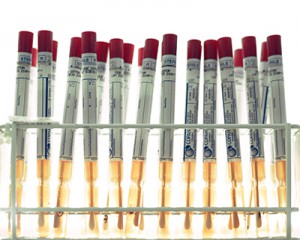Ask the Expert: Dr. Kathryn Porter
Posted on by
Since 1991, the National Health and Nutrition Examination Survey (NHANES) has collected and stored genetic specimens for future studies. Among other considerations, whether, when, and for which biologic measures the results should be reported back to individual survey respondents is a growing concern. NCHS has developed an action plan for reporting individual results; however, the NCHS Board of Scientific Counselors recommended gathering further input from a wide range of perspectives.
The National Academies of Science recently convened a workshop to fulfill that goal. The workshop, “Guidelines for Returning Individual Results from Genomic Research Using Population-Based Banked Specimens”, was held February 10 and 11, 2014, at the National Academy of Sciences in Washington, DC.
Prior to the workshop, Dr. Kathryn Porter, Director of the Division of Health and Nutrition Examination Surveys (DHANES), discussed the history of NHANES and genomic research, and the issues facing NHANES and other population-based surveys.
Q. Can you give some background on the upcoming workshop?
A. The issue for us and other population surveys in the United States that have decided to collect specimens for genetic studies is, “What do you tell individuals who participate in these studies about the genetic tests and their individual test results?”
Since the continuous NHANES [National Health and Nutrition Examination Survey] started in 1999, we have been using a separate consent form to ask participants [aged] 20 years and older if we can collect and store a blood sample for future genetic studies. As part of that consent, we had to provide an answer to the question, “What genetic tests will be done?” The answer, in short, was, we don’t know. Genetic studies on banked samples are done in the future at a time beyond when the consent form is signed.
Use of the NHANES DNA specimens is governed by a proposal process. Research proposals received by the NHANES program are reviewed by DHANES staff, a genetics technical panel, and the NCHS Ethics Review Board. If the proposed research is approved, specimens are released to the researcher. We don’t know in advance what proposals will be submitted. Therefore, we can’t tell participants what genetic tests will be done.
The next question we had to answer was, would participants receive their genetic test results? We made a decision not to return individual results to participants. Given that, we had a policy not to accept research proposals to use the banked specimens if the test results would have clinical relevance—[that is,] a valid finding that would have importance to a participant’s health. Since 1999, genetic technologies have advanced. With genome-wide association studies, researchers are learning so much about someone’s DNA that findings incidental to the original research may be detected. Therefore, we faced a dilemma. Incidental findings could be of relevance to a participant’s health, whereas findings from the proposed research were not.
So the questions for this workshop are going to be, “How should population-based surveys, like NHANES, implement reporting of results from genomic research? What are other population-based surveys doing? What are the ethics of returning the results of genomic research?”
Q. You’ve been requesting genetic specimens for quite some time. How many thousands of samples do you have?
A. We actually started asking people if we can store specimens in the later part of NHANES III (Phase II), so we have DNA specimens from 1991. To date, we’ve collected DNA specimens from 28,600 adult participants.
Q. Is the request in the survey now?
A. No, we stopped collecting DNA specimens in January 2013.
Q. Will it be back in 2015?
A. I don’t know. It depends a lot on what happens in this workshop.
Reporting genetic test results is complex. It’s not like reporting a high cholesterol level, or high blood mercury level. The result could be a single nucleotide polymorphism that may increase the likelihood that a participant could develop a certain health condition. How do you put that into simple words for a participant to understand? Would we need to hire a genetic counselor? We face hurdles ahead. In fact, we recently closed our DNA specimen bank to new proposals and won’t reopen it until we resolve some of our ethical issues.
Q. Currently with NHANES, if somebody has blood work done, and it comes back with something that raises a red flag—it might be diabetes, it might be high cholesterol—we can contact those people with that information?
A. Yes. That’s part of the consent. We tell people what they can expect as a participant in NHANES. They are provided information about health measurements that are part of the exam—blood pressure, height and weight, blood tests, bone scan, dental exam, etcetera. We also indicate whether or not they will get results. Some tests are routinely reported, because they are clinically useful. For example, there’s a blood test that tells us if kidneys are working correctly; it’s called serum creatinine. And we report it if is normal or abnormal.
We’ve designed this Report of Findings program where we give participants feedback at different stages after the exam. When they finish the 3½-hour exam, they walk out of the exam center with a preliminary report. They get their height and weight with an interpretation, they get their blood pressure with an interpretation, and they get a complete blood count with their hemoglobin, hematocrit, and platelet count. There are other results we give them right on the spot.
About a month after the survey, we start to get all data back from laboratories that do our laboratory assessments. We receive blood sugar results, lipid profile results, nutritional biochemistries, and other results. We’ve already set flags for when these results come back, so if results meet the criteria for being abnormal, a letter is sent out immediately. If participants have a high blood sugar, or high triglyceride level, they get an early report in the mail.
The Final Report of Findings is sent out about 12 to 16 weeks after the exam. Participants get a full six- to seven-page report of nearly everything that they had in their exam. So, the question is, where would the genetic testing result fit in with this?

Q. Is the genetic testing done along with the other lab testing, so you have the results?
A. That’s the point, it’s not. We have permission to store these specimens. Tests are done at some point in the future. As I mentioned before, we actually started collecting specimens with NHANES III in ’91. So we have participants with banked samples who were examined 23 years ago. The question is, would it be right to report back to somebody with a clinically relevant genetic finding who was examined 23 years ago?
DHANES held a small workshop in 2011 to ask experts about reporting incidental findings from genetic studies. Experts recommended that the NHANES program report genetic variants that are determined to be clinically actionable. DHANES considered re-contacting participants with stored specimens to let them know we may be changing our procedures and that they could be notified in the future about a genetic finding that could be important to them. They would have a chance to opt out. This process is called reconsent. The NCHS Board of Scientific Counselors thought we should get additional input before moving forward with this.
Q. So that would be an opt in on the part of the respondent?
A. Yes. But the reason why we didn’t do that is because we felt we need more advice. And that’s the reason for this workshop. A lot of time and money is needed to find and contact participants. Is this really the way we want to go? We thought the experts should weigh in, before we go back and reconsent and say, “Hey, we’re changing the way we’re thinking about this.”
Q. If you decided to reach out to everyone, and, then, going forward make that part of the consent form, would it still be just storage, or would you implement some sort of analysis in the same way you have with NHANES?
A. That’s a really good question. Genetic technologies have gotten to a point where it costs $3,000–$4,000 to do whole genomic sequencing on an individual. We could do away with storage entirely if we added whole genome sequencing to the live survey. I don’t know if this is even feasible. Whole genome sequencing could only be considered if we received a proposal for new content that included funding support to add this to NHANES. The proposal would have to meet all the criteria for acceptance as new laboratory content. We would have to figure out what to report back to participants and how to do this, and if the sequencing could be done in a 3-week time period (which is the requirement for our other reportable laboratory tests, like blood lead). Not easy questions to answer, but the questions are intriguing.
Q. What do you think is the biggest issue you face? Is it the confidentiality, the costs, is it the implementation of a whole new mechanism?
A. I think it’s the fact that we’re a cross-sectional study, and we don’t have an ongoing relationship with our participants. If we consider providing test results from genetic studies to participants who were initially examined 10, 15, 20 years ago—is that OK? That is not easy. I think it is perfectly appropriate for longitudinal studies that have ongoing contact with participants to give them feedback about what they’re learning about their health. For NHANES, it is different.
Q. Will NCHS personnel give the presentations at the upcoming workshop?
A. I will be doing an overview of NHANES on the first morning of the workshop. All other presentations will be given by university researchers and representatives from population-based health studies and federal agencies.
Q. And a transcript is available to anyone who requests it?
A. Presentation materials and summaries will be posted on the National Academies of Sciences website.
Q. Would this issue affect whether or not you include it in the next round of NHANES?
A. It will play a role, but like many federal programs, we are struggling with smaller budgets. Can we commit to restarting collection and storage of genetic samples? I don’t know. Can we navigate the ethical issues—I hope so. I would ultimately like to see the NHANES DNA bank used widely by researchers to enhance our knowledge of the health of adults in the United States. The NHANES DNA bank is a tremendous resource because the specimens are representative of the U.S. population.
Posted on by

